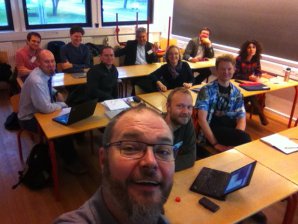e-tools

First WP meeting in Copenhagen.
Coordinator: Peter Willendrup (DTU)
Partners: DTU, ESS, STFC, PSI, TUM, TU Delft, NPI, ESS-B, MTA EK
Overview
The ground-breaking developments of e-science have strongly influenced the way the neutron community sees not only data treatment and interpretation but also the interplay between science and instrumentation. Simulation tools help to plan and optimise neutron sources of the present and future (neutronics), design complete instruments and simulate experiments. This instrumentation task embraces several, distinct e-science related activities to provide an integrated approach to neutron instrumentation by incorporating neutronics and thus enable optimisation of instruments from the source to the sample and the detector, including the background signal (i.e. noise). The goal is to combine the world-leading, European expertise in this field and enable the elaboration of qualitatively new approaches and new developments leading to innovation.
Tasks and Partners
Task 1. E-tools for integrated simulation using neutronics and Monte Carlo ray-tracing
Task Leader: DTU
Partners: PSI, NPI, ESS-B, MTA EK
This task will develop and assess new e-science tools for very accurate simulation of neutron beam-lines. The activity brings together experts from both (a) neutronics, e.g. MCNP used for simulating production and transport of neutrons from the target through moderators and reflectors and (b) Monte Carlo ray-tracing, e.g. McStas and RESTRAX, which simulate the transport of neutrons along guides and their interaction with other optical elements and samples. The combination of these two types of code will give a unique tool for optimising instruments and experiments from the source to the sample, including shielding and thus background optimisation. This will increase the realism of neutron simulation to a completely new level, since also unwanted spurious scattering signals are modelled, thereby addressing the signal-to-background ratio of instruments for the first time. Based on existing prototypes, the collaboration aims to deliver an easier-to-use and benchmarked solution, as well as establish networking and knowledge sharing between the partners and facilities.
Task 2. Innovative Shielding Concepts and Materials
Task Leader: PSI
Partners: ESS, ISIS, ESS-B, TUM, MTA EK
The task will enhance our understanding of high-energy neutron background, and optimise biological shielding through the development of new materials. The activity combines detailed, fast neutron background measurements at PSI and ISIS, which will be carried out using procedures common in the high-energy physics community and confronted with simulations. This work will lead to better neutron instrument design with lower fast neutron background. The development of new shielding materials will also reduce the costs of neutron instruments since, nowadays, shielding constitutes an important fraction of an instrument budget. The new concepts will be tested at PSI on the BOA beamline, and at ISIS on the ChipIR beamline, before being more widely deployed.
Task 3. Compact Instrumentation for Larmor Labelling applications at the ESS
Task Leader: TUD
Partners: ISIS, MTA EK, ESS
This task aims to investigate the implementation of new magnetic field configurations, e.g. triangular coils, which should lead to compact Spin Echo SANS and Larmor diffraction instruments and therefore high brilliance combined with high performance. This will result in new instrument designs for both monochromatic and wide-band (time-of-flight) operation. This development will be of particular relevance to the ESS, where the proposed flat (pancake) moderator design will result in high intensity, small cross-section neutron beams that are well-adapted to small samples and compact instruments.




